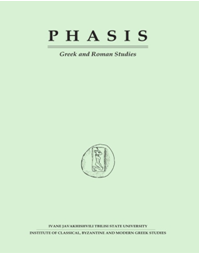Typological Correlations of the Symbol of Wine in Byzantine Exegesis
DOI:
https://doi.org/10.60131/phasis.17.2014.2332Abstract
My analysis of exegetical interpretations of biblical wine is based on the typological method of Bible exegesis. Typological interpretation is one of the main and probably the most popular methods of Biblical hermeneutics in Byzantine exegetic literature. Typological parallelism enables us to comprehend the basic concept of the Bible – i. e. the integrity of both Testaments, and to view biblical imagery in eschatological terms. The semantic field of wine as a typological symbol shows systemic reference to the mystery of the Eucharist. The basic exegetical line focuses on the analogy of wine with the Blood of Christ. According to the allegoric interpretation, it represents divine gladness, which in turn relates to the joy of the Holy Communion and thereby continues the basic symbolic line. At the same time, wine is closely linked with the symbol of water, which likewise leads us to the mystery of the Eucharist. The same symbolic line is developed through the eschatological interpretation of wine. Thus, we can loosely say that the exegetical coverage of wine does not go beyond the Eucharistic context. On the other hand, as discussed above, wine, like other biblical symbols, may also have a negative connotation determined through its relationship with the image of vine. Finally, it should be mentioned that this key symbol of the Christian mystery has the same semantic range in both Testaments.Downloads
Published
2014-05-17
Issue
Section
Articles
License
Copyright (c) 2018 PHASIS

This work is licensed under a Creative Commons Attribution-NonCommercial 4.0 International License.


